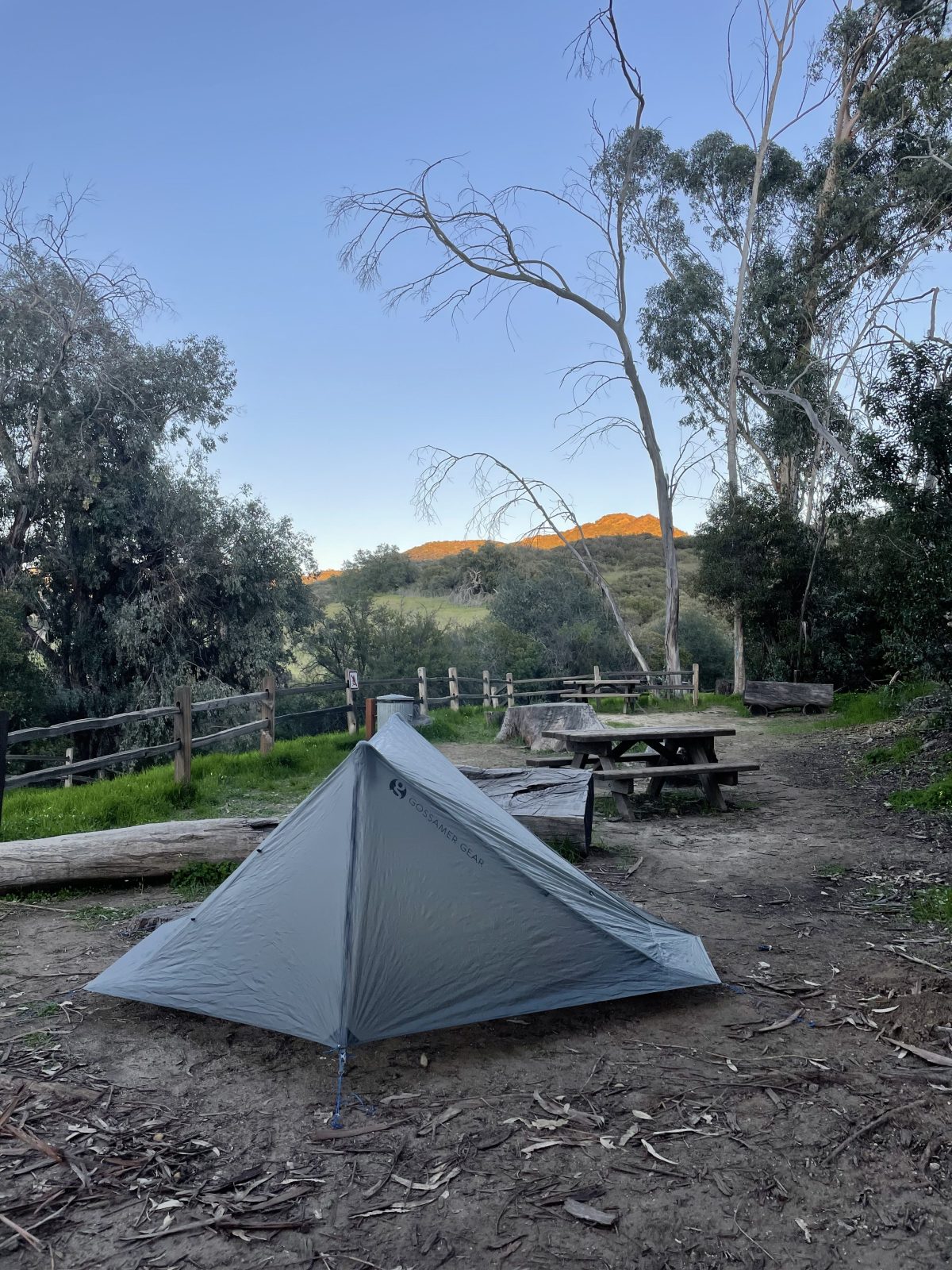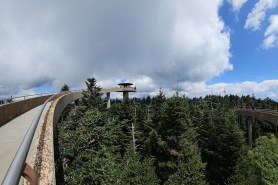

Backpacking is one of the most accessible outdoor sports to break into. Backpacking, at its core, is overnight hiking. Hikers carry everything they need in their backpacks—from their shelter to their food. While this might seem overwhelming, you don’t need super fancy gear or an extensive course to get your boots on a trail—but finding a route that’s accessible for beginners might be a bit challenging for someone who’s never overnight camped before.
Videos by Outdoors
There are a few things to consider when picking your first overnight trail, including trail length, permits, and water accessibility. You want to make sure that you’re picking a trail that’s within your physical abilities. It’s important to remember that backpacking is much harder than day hiking, and carrying 30-40 pounds on your back can be harder on your body than you’re used to.
Backpacking for Beginners, Some Basics
If you’ve never hiked 15 miles before, that’s probably not a good place to start. It’s a good call to choose a trail that’s shorter than your favorite day-hike distance, just in case your body feels more tired from carrying your pack. It’s also important to check permit restrictions. Some locations require you to apply for a permit in advance in order to camp there, such as the Grand Canyon or Washington’s Enchantments. Some places allow you to self issue a permit at the trailhead, like the Mount Hood National Forest. And some places don’t require a permit to backpack at all.
Remember to pack appropriate clothing according to the weather forecast, and try your best not to overpack. You will need a pair of hiking shorts or hiking pants, base layers, a hiking jacket, and other essentials.
One more detail that beginners often overlook is access to water. When you’re day hiking, you’re likely carrying all of your water for the day with you. When you’re backpacking, however, you’ll likely need to filter water while on trail. For your first overnight trip, it’s incredibly important to choose a trail that takes less planning when it comes to water sources. That way, you can learn how this works in a less stressful environment. For that reason, we’re avoiding the desert in this post.
Read more about the debate between lightweight vs ultralight backpacking.
These are five amazing trails to consider for your first trip.

5 Backpacking Trips for Beginners
1. Chain Lakes Loop, Mount Baker Snoqualmie National Forest, Washington
The Chain Lakes Loop is not only one of the most beautiful trails in Washington, but it’s also a perfect trail for beginner backpackers. This loop trail is just under 7 miles long, with just under 2,000 feet of elevation gain. You will hike through the incredible Mount Baker Snoqualmie National Forest with stunning vistas of mountains and lakes throughout the trail. There are plenty of places to camp along the loop, so you can choose how far you hike over the course of a recommended two days. Also, due to the number of lakes on the trail, filtering water should be no problem.
Perks of hiking this trail:
This is a fairly popular trail in the summer, which means you’ll likely see other hikers. Sometimes the presence of others can give peace of mind while in the wilderness. This trail is also dog friendly, as long as your pup stays on a leash.
Things to consider:
Washington State is black bear country. It might be worth adding a can of bear spray and a bear canister for food storage to your pack, which you can pick up at most outdoor retailers in the area.

2. Eagle Creek Trail, Columbia River Gorge National Scenic Area, Oregon
While this trail can be quite long, it is fairly flat. This makes it a good option for hikers who like walking longer distances but might be unaccustomed to doing so with pack weight. Eagle Creek is one of the best places to see Columbia River Gorge waterfalls, including the famous Tunnel Falls, located at mile seven.
The amazing thing about choosing an out-and-back trail like this one is that you can hike out as far as you’d like, camp, and simply turn around—there is no rule stating that you have to hike all the way to the end of the trail at Wahtum Lake. There are several durable campsites that you will see along the way, but many people choose to camp near the lake. Completing this trail in its entirety will bring you up to about 27 miles, with very gradual elevation gain.
Perks of hiking this trail:
This is one of the most scenic trails in the Columbia River Gorge. You’ll see lots of waterfalls, including Tunnel Falls, Twister Falls, and Punchbowl Falls, and it’s nice getting to go out and choose your own adventure with your distance. This could be a good way to gauge how far you’re comfortable walking with pack weight. Dogs can join you on this trail, as long as they’re on leash.
Things to consider:
This trail is not for people who are afraid of heights. This trail features many steep drop offs along the way. This is another reason to keep dogs on leash at all times. There is also the possibility of water crossings on this trail, so either be prepared to get your boots wet or bring water-crossing shoes.

3. Backbone Trail Section 1 Westbound, Santa Monica Mountains National Recreation Area, California
This trail is a little different in that it is located within a big city. It’s the perfect trail and section for beginners, however, because when you’re close to society, some of the anxiety about being in the backcountry melts away. The Backbone Trail is a 70-mile point-to-point trail, but it’s easily divided up into five distinct sections.
Starting at Will Rogers State Historic Park and hiking westbound, hikers can follow the trail into Topanga State Park and down to Musch Camp—a walk-in only developed campground. You will have to hike all of your gear in, just like a classic backpacking trip, but you won’t have the stress of having to find a campsite. Musch Camp has water, picnic tables, and bathrooms, and it costs $7 to camp there. This is a great way to test out your gear, without throwing yourself deep into the wilderness on your first go. This section is approximately 10.5 miles long, one way. Hike out the way you came for a 21-mile total trip.
Perks of hiking this trail:
Since this trail is largely in the front country, there will be lots of other people around. This can provide a sense of security, especially if this is your first time camping out on a trail. This trail also allows you to experience one of the only true Mediterranean climates in the world, right in southern California.
Things to consider:
Due to the location of this trail, it’s a good idea to try this section in the winter. This area gets extremely hot in the summer and can be dangerous for inexperienced hikers. Dogs are not allowed on this section of the Backbone Trail.

4. Harbor Hills Loop, Isle Royale National Park, Michigan
Stepping away from the west coast and into the rough and rugged wilderness of Isle Royale, the Harbor Hills Loop is perfect for the beginner backpacker wanting to experience multiple days in a true wilderness setting. Isle Royale is one of the most difficult U.S. National Parks to visit—mostly because you can only access it by boat, and this access closes in the winter.
The Harbor Hills Loop’s length depends on which boat you take. It will be 33 miles for passengers on the Queen IV and 24 miles for passengers on the Ranger III. Isle Royale is beginner friendly due to the fact that most of its terrain is not very steep. The National Park Service recommends approximately five full days for this trip, especially for beginner backpackers, and it can easily be broken up into short days averaging 3-8 miles.
Perks of hiking this trail:
Isle Royale is a wilderness experience like no other. This park is home to some of the most incredible wildlife, including moose, and there’s truly nothing like being dropped off on an island in the middle of Lake Superior.
Things to consider:
This is easily the most remote trail on this list. This would be a great trip to test out a satellite communication device like a Garmin inReach. Due to the presence of wildlife, it’s very important that you learn how to store your food properly on this trail. Dogs are not allowed in Isle Royale National Park.

5. Hell Roaring Lake, Sawtooth Wilderness, Idaho
Most people wouldn’t think of Idaho when they picture scenic vistas, lakes, and mountains, but the truth is, Idaho is extremely underrated when it comes to beautiful landscapes and backcountry travel. The Sawtooth Wilderness has incredible mountain views, and Hell Roaring Lake is no exception. The Hell Roaring Creek Trail is 11.1 miles out and back to Hell Roaring Lake. This trail is good for beginners mostly due to the low elevation profile of only 800 feet over the entirety of the trail. This trail offers stunning views of the Sawtooth Mountains, and it is the perfect place to experience Idaho’s landscape for the first time by foot.
Perks of hiking this trail:
Not many people travel to Idaho for hiking and backpacking—it’s one of the most underrated states in the country for outdoor adventure. This is a good way to experience a less-trafficked trail with amazing views. You can also bring your dog along with you, as long as it’s on a leash in peak season, which is July first through Labor Day.
Things to consider:
This is a fairly accessible trail for beginner backpackers. There aren’t a lot of things to consider when planning your trip here, but if you are bringing a dog, pay attention to that peak season restriction.
Backpacking doesn’t need to feel intimidating, if you know where to start. Between Idaho’s Sawtooth Mountains, Isle Royale’s remote wilderness, and the beautiful west coast, there are tons of options for anyone wanting to break into backcountry travel this upcoming season.










Pingback: Cowboy Camping is Camping Without a Shelter - Wander Products